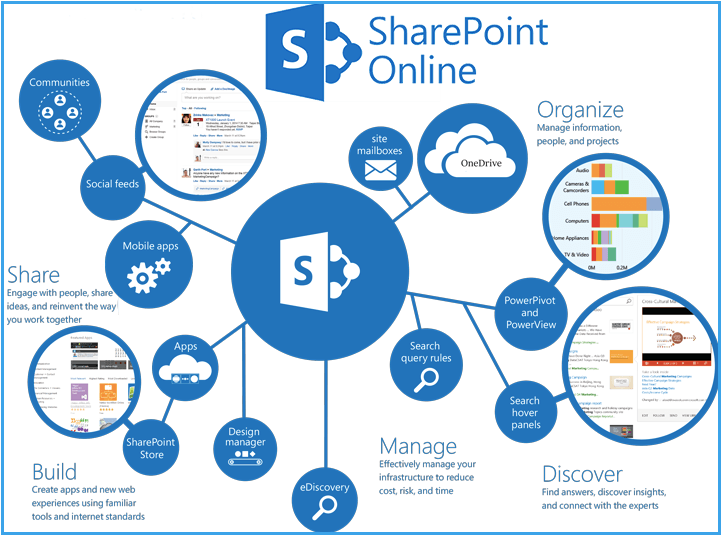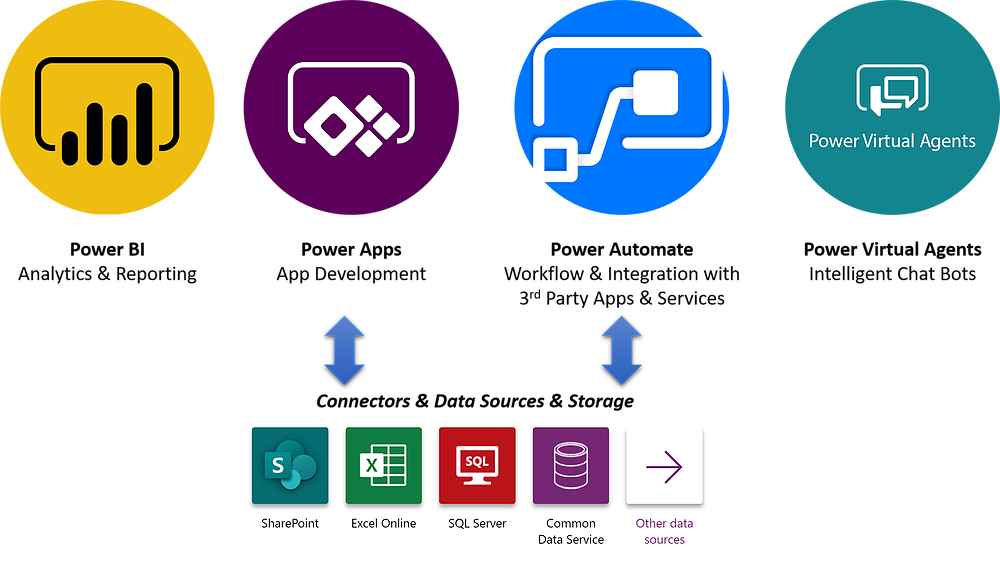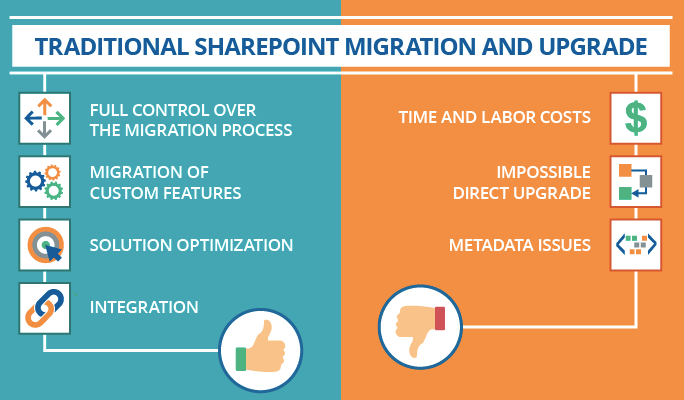Month: August 2020
Modern business users want tools that make them productive and engaged. Office365 is considered to be one such tool which is constantly evolving and moving towards Microsoft’s vision of the one-stop online-productivity hub. Microsoft SharePoint in Office 365 has now practically shaped the way organizations collaborate within their establishments. More than 75%* of Fortune 500 companies and over 100 million people across the globe now use SharePoint.
Earlier SharePoint was launched as an application for document management. But slowly, it evolved into document management and records management alongside web content and portals, thus turning into a robust collaboration and content management platform. With just a web browser, organizations could store, organize and share information accessible from any device.
Unlike the on-premises version, SharePoint Online is a Microsoft managed cloud solution that can be used for creating intranet and websites for public use. The biggest question that arises is why should businesses migrate to SharePoint Online? Not everyone is comfortable with this migration from SharePoint On-Premises to SharePoint Online, but the long-term rewards are endless.

A few reasons why businesses should migrate to SharePoint Online are:
99.9% Guaranteed Uptime
This frees up the user to focus on the company’s performance instead of worrying about whether the services are reliable or not. With an outstanding support team, SharePoint online remains available around the clock for 365 days in a year.
Zero Server Footprint
SharePoint On-Premise required in-house teams for maintenance and technical support whereas all technical assistance for back-end processes in SharePoint Online is handled by the Microsoft Team. This means that all underlying hardware and platform problems, as well as, server upgrades and patches are covered by Microsoft. This is a major advantage as it becomes cost effective.
Enterprise Security Solutions
As SharePoint Online is managed by Microsoft, all users get enterprise-level security features to protect their confidential and sensitive data critical to their business. The data is stored in Microsoft’s data centers distributed around the globe and has 5 layers of Security, Proactive Monitoring and Operations Access Restriction, thus making it highly secure from the outside world.
External User Access Management
Managing security issues while allowing users to access SharePoint On-Premises is one of the major challenges in the legacy system. SharePoint Online simplified this process and made file sharing using Services Management Portal easier for collaboration.
Hybrid Environment
Businesses can continue to use their On-premises server while transitioning to the cloud to take advantage of SharePoint Online. This solution is perfect for businesses that are worried about compliance challenges such as data breaches if they move to the cloud model. While the most confidential business data can still be kept within the organization, others can be moved to the cloud for greater scalability.
Power Platform Ecosystem
Power platform is tightly integrated with SharePoint and provides you with the capability to create apps, automate business processes and visualize data. As Power Platform is a low code no code environment, getting started is easy but it doesnot limit you from building a full-scale mission critical solution.

Evergreen Service
The latest features, patches, and security updates are available to all SharePoint Online users as soon as Microsoft makes them available. Whereas, these features are available on SharePoint On-Premise only in the next major release, so they remain stuck with the point release model. Since new features are automatically pushed to SharePoint Online, its users get to enjoy the upgrades much earlier.

Enterprises invest a lot of money in SharePoint and concern themselves about reaping the benefits of their investment.
Based on a survey by 274 AIIM, 40%* SharePoint implementations are not successful.
A few challenges that organizations face when implementing SharePoint Online are:
User Adoption
User Adoption is a serious issue that many admins of SharePoint face in their organization. After deploying SharePoint, many enterprises replace file servers with document libraries, so that the indexing power of SharePoint helps in locating the documents quicker. But overloading document libraries makes the task tougher for the user to find the required information within the library.
User Interface
Intranets of SharePoint are inept with static pages and interactive tools. Some admins of SharePoint spent a lot of time and energy on customizing the intranet that can match the organization’s brand and provide a better user experience (UX).
Bulk Migration
It is quite possible that files may not end up in the correct location or can get corrupted during the migration. There is no general rule to take care of this but having similar file types maintained in specific folders helps. Also, there are third-party tools available in the market that are intelligent enough to identify and migrate content based on its type.
Loss of Metadata
While migrating, all or some metadata that was defined previously might get lost. To overcome this scenario, one must clearly define an inventory of the content, before starting the migration journey, and organize it well with the content types.

After analyzing all the benefits and challenges, another question that arises is what can one do to ensure a smooth migration? Users must spend time to analyze the content, their owners, the structure, and their importance. This shortens the overall migration timeline. Not only does this remove redundant and obsolete data but also helps prepare a governance plan.
SharePoint has transformed from a simple on-premises application into a comprehensive solution for collaboration, management of records and documents, and a system for managing portals and web content. It has helped countless businesses increase their productivity. The newer versions such as SharePoint Online cannot even be compared with the legacy versions that are incompatible with modern business requirements. Needless to say, migration from SharePoint On-Premise to SharePoint Online has become a necessity for modern features.
References:
*Top 5 rollout challenges faced by enterprises, April’20. Revived from: https://www.apty.io/blog/top-5-sharepoint-rollout-challenges-faced-by-enterprise
In 2020, low code speaks about a movement within technology because, in future, 50%*** of all new business applications will be created with this visual coding tool. If you are not familiar with the term low-code platform for app development, then get ready because you are about to start hearing it everywhere. Global businesses are now creating add-on pressure on developers in demand for multichannel applications to gain competitive advantage. In that scenario, low-code development platforms are accelerating the delivery of business applications with high productivity and offering better customer experience.
The worldwide low-code development platform market generated $10.3 billion revenue in 2019 and is expected to witness a CARG of 31.1% during the forecast period of 2020-2030**. Most of the tech companies consider low-code application platforms because it requires minimal coding and enables faster delivery with the help of pre-packages templates, graphic design techniques, and drag-n-drop tools. Below, three key factors work as driving force in this platform:
- Increasing demand for business digitization
- Less dependency on the information technology
- Stringent government norms on technology adoption

According to the Salesforce.com survey report, over 76%* of IT professionals were profoundly interested in low-code app development, which may scale up to 81% in 2021. More than half of the business is now happening using the low-code programming because developers consider this process viable for the development of the mission-critical application and high-level programming language.

The rapid digital transformation has created a significant impact on major industries like Retail, BFSI, FMGC, E-Commerce, Media, and others. Undergoing process of digitization is a multi-faced journey, and not a single tool or approach will make the transformation to reality. But the bespoke platform can play a central role in the mixed method of digital transformation by reducing the load on IT and accelerating development time than traditional development process. This low-code solution empowers users to build solutions to meet their exact requirements that increase organization agility. This rapid transformation can evaluate the company brand position in this competitive market with a better customer experience.

The ongoing outbreak of COVID-19 is working as an additional fuel on the growth of low-coding platforms. This global pandemic pummels the economy, shredding profits and millions of jobs, now organizations are looking for a new platform to change. In that scenario, low-code automation is helping organizations adapt to massive disruption by quickly combining human and digital labor in the same workflow. COVID-19 has resulted in some of the complex problems mentioned below, for which low-code offers an excellent solution.
- Rapid business transformation in Retail and Healthcare
- Immediate need for applications
- A drastic shift in business strategy models
- Technical debt, and unavailability of talents become burden for companies

This pandemic has forced many small retailers and healthcare organizations to adopt or leverage their online marketing just for survival. Education, Pharma, and other small businesses are now depending on low-code solutions for an immediate need for new software applications. Self-reporting apps on disease symptoms, apps for online classes, government apps for the temporary service are now of outrageous demand. AD&D services in the insurance sector, airlines, retail, and healthcare are in the first row of low-code app demand. Moreover, cost of maintenance and update is quite low in this platform that can reduce company technical debt.
As per the Gartner report, Salesforce, Microsoft, Mendix are the topmost service leaders in fastest-growing low-code environment who have configured the cloud-native deployment options to minimize the operational risk and align organizational needs.

At Inovar, we are fully aware of the benefits of the low-code development platform and have aided one of the biggest healthcare centers in the US. We have helped them to migrate from their existing manual process to a low code solution to help patients amid this global pandemic. It was a comprehensive solution which included, dashboards, online forms where patients can ask any query or find details regarding doctor consultation quickly.
The old way of doing things might not die out completely, but people may be more reliable on low-code platforms as low-code programmers are going to lead the development environment. In a nutshell, in the era of rapid transformation, maybe companies won’t get much time to follow the lengthy development process or reinvent new wheels that can make apps redundant before they are even released. It will be the best time to believe in empowering IT developers and supporting them in creating a whole new ecosystem of application development.
Hence, do not allow yourself to be on the wrong side of history and empower your business with the right trend of the market.
References
* LOW CODE DEVELOPMENT PLATFORM MARKET – GROWTH, TRENDS, FORECASTS (2020-2025), Mordor intelligence, Retrieved from: https://www.mordorintelligence.com/industry-reports/low-code-development-platform-market
** Low-Code Development Platform Market Research Report: By Offering (Solution, Service), Deployment Type (Cloud, On-Premises), Enterprise (Large Enterprises, SME), Vertical (IT, BFSI, Retail, Healthcare, Government, Manufacturing, Media and Entertainment, Education, Energy and Utilities) – Global Industry Analysis and Growth Forecast to 2030, PRESCIENT& STRATEGIC INTELLIGENCE Retrieved from: https://www.psmarketresearch.com/market-analysis/low-code-development-platform-market
How Low-Code Technology Accelerates Digital Transformation Retrieved from:
https://www.businessprocessincubator.com/content/how-low-code-technology-accelerates-digital-transformation/